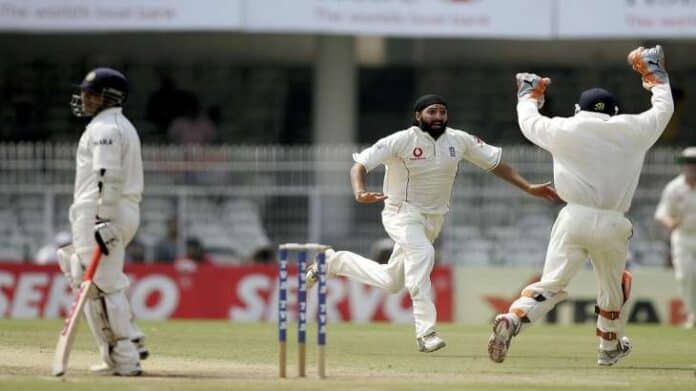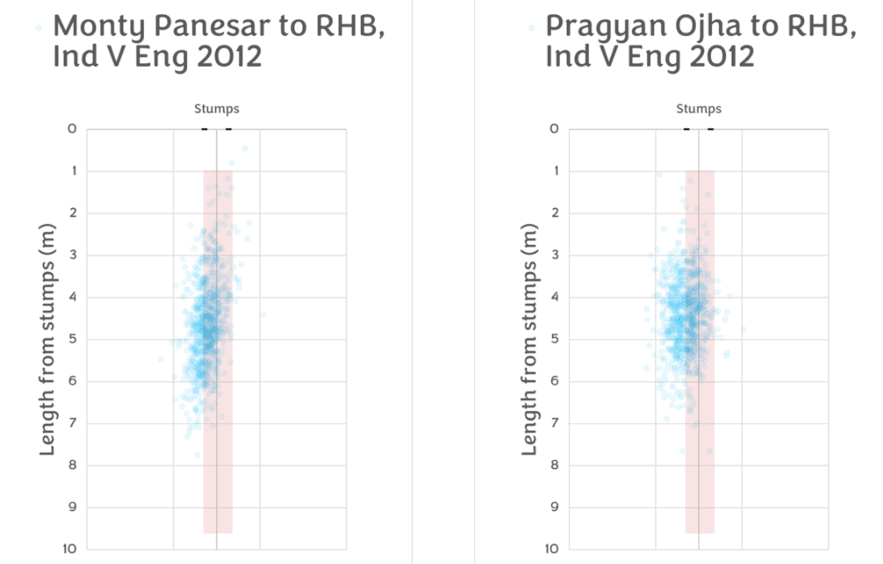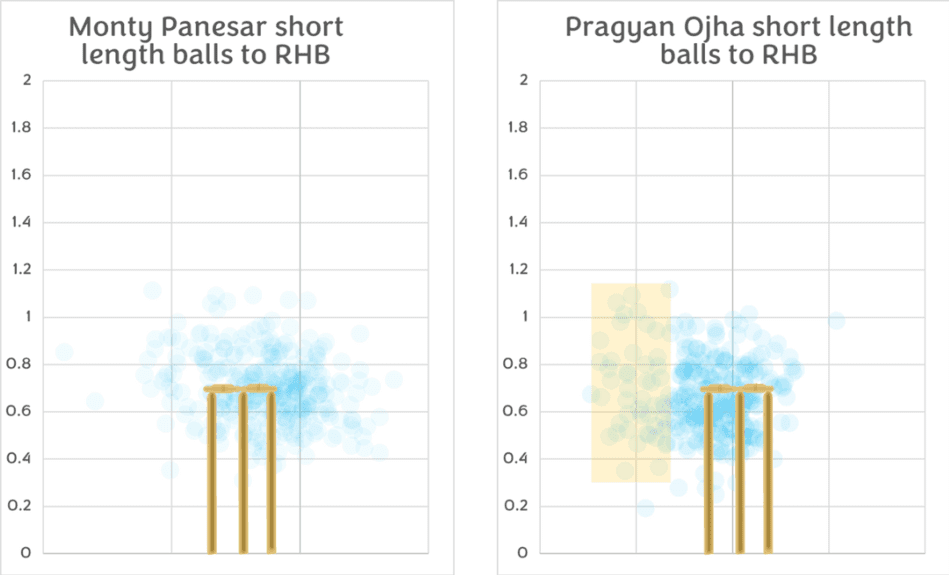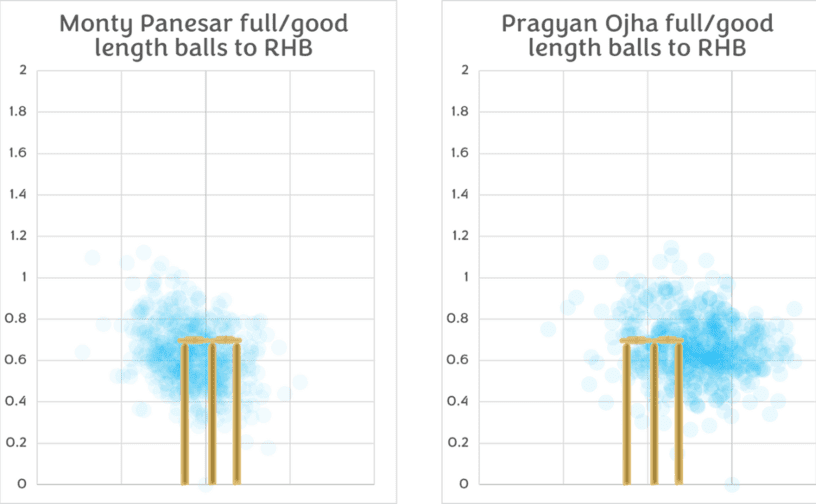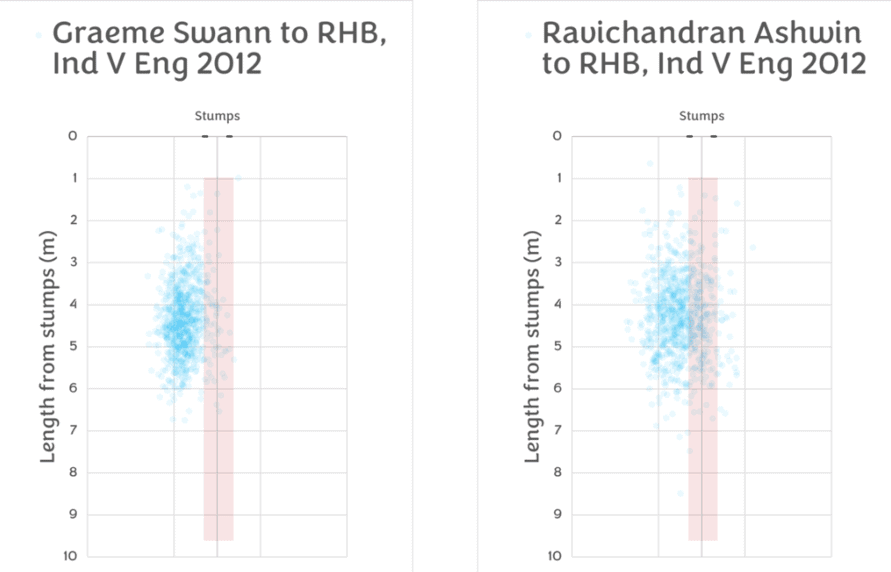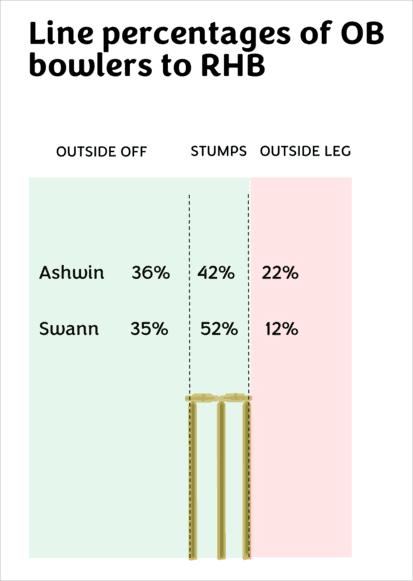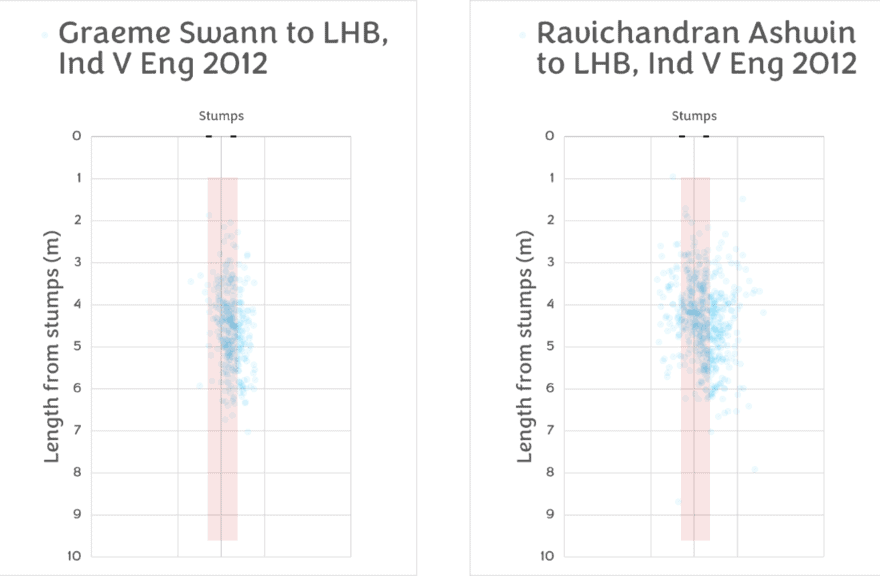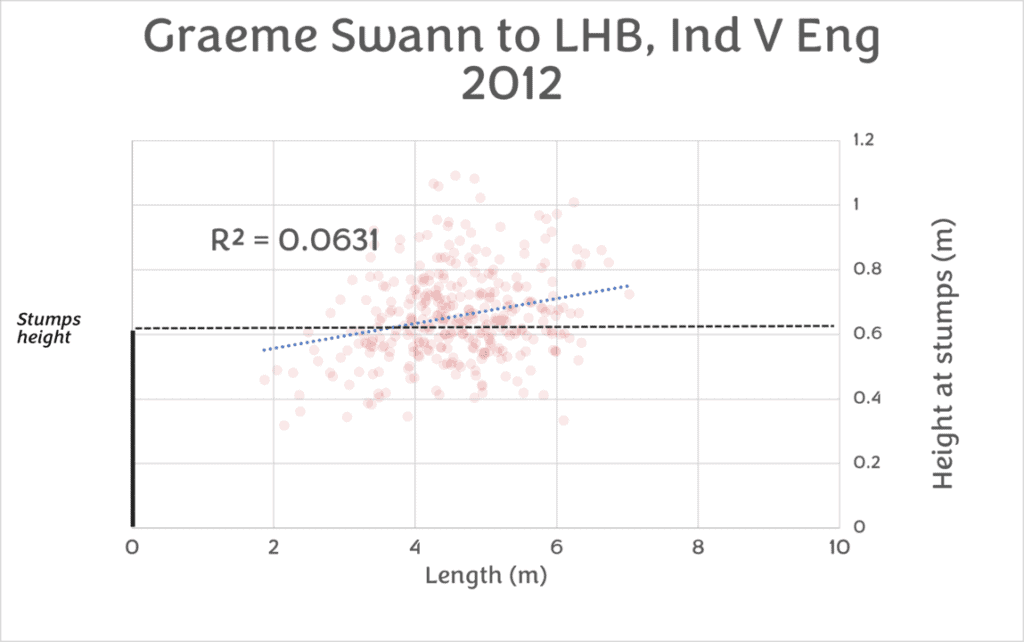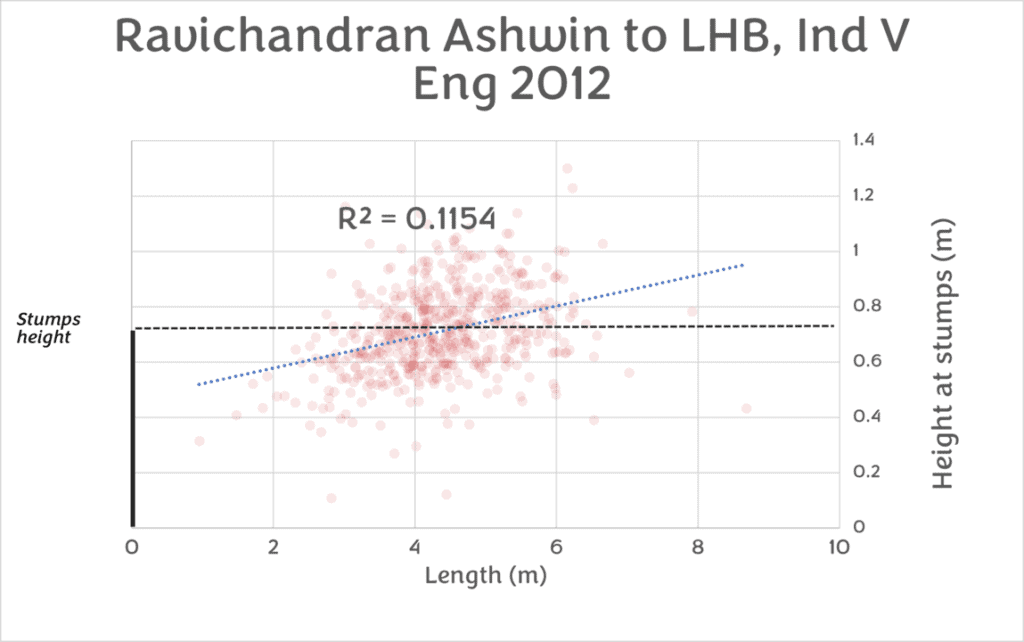India has strangled, deconstructed and bamboozled teams at home for nine years, redefining the meaning of home-ground advantage. As India and Australia prepare for the 2023 Border Gavaskar Trophy, it’s worth taking a look at how they were outbowled by England in 2012, their last home series defeat.
England entered the Indian series with two of the best finger-spinners produced by their country, who offered different directions of turn – Monty Panesar (Slow Left Arm) and Graeme Swann (Off Break), while India mainly employed Pragyan Ojha (SLA) and R Ashwin (OB). This parallel makes for a fascinating comparison in the spin bowling strategy of the sides. As both batting orders were mainly constituted by right-handed batters (RHBs), this piece will focus mainly on bowling strategies against them.
Let’s begin with the Slow Left Arm bowlers and analyze their strategies. When bowling to RHBs, SLA bowlers aim to pitch the ball in the line with the stumps (indicated by the red zone on the below pitch maps) so as to maximize the chance of a wicket.
The most obvious difference in the strategy of the two SLA bowlers is the spread of line. Ojha pitches the ball further outside the line of off stump, which is to be expected from an SLA who delivers from wider on the crease.
A term for Panesar’s line that immediately springs to mind is ‘tight’. His cluster of balls is gathered much more tightly around the line of off stump and expands down the pitch, rather than across it. It is a type of pitch map in test match cricket that commentators often conflate with accuracy, patience, and superior technical skill. However, this is not the only glaring difference between the bowlers.
Why does Panesar deliver so many balls shorter than 5 meters, while Ojha is happy to pitch the ball much closer to the bat? Generally speaking, bowling a shorter length is advantageous for a spinner, under two conditions:
- The ball is consistently threatening the line of the stumps.
- The short length does not allow batters to play on the back foot and score quickly to release pressure.
If these two conditions are mostly or fully met, it essentially removes the option of front-foot aggression for a batter and nullifies the attacking option of running down the pitch. While the wicket opportunity decreases as the ball pitches further from a good length, it can prove a valuable tool in building pressure and limiting scoring. More on this later.
Throughout the series, Panesar and Ojha returned a similar economy rate, 2.3 and 2.4 Runs Per Over respectively. But Ojha’s short-length deliveries were scored off rapidly at 3.6 RPO, while Panesar’s short-length deliveries only conceded 2.25 RPO – even better than his overall economy for the series.
How is this possible? India’s batters were not inept at playing spin from the back foot, in fact, they boasted a batting order of excellent spin players – Sehwag, Pujara (in stunning form), Tendulkar, Yuvraj and a young Virat Kohli. The difference between Panesar and Ojha is that after pitching the ball short, it ended up in very different places, nearly opposite from one another.
Pragyan Ojha’s short-length balls provide width. With the same amount of spin from the pitch, a ball pitched on a shorter length will naturally end up wider from the off stump when it reaches the batter. This results in the balls highlighted in the yellow zone, which can be cut and punched through the off side with relative ease.
Most of the balls in the yellow zone can be deemed ‘failures in accuracy’, where the aim of Ojha was to drift the ball and spin it to catch the outside edge, but the ball did not land near enough to the batter to prompt a forward defence or drive. These deliveries are a release in pressure for the batter.
One way to think about Ojha’s bowling is that there is a light at the end of the tunnel for any RHB who is batting with low risk against him. That is, they can securely defend 7 good length balls in a row and be confident in the knowledge that if they get a short length ball, they can still score 4(8) from those eight balls – a healthy test match strike rate.
So why does Panesar’s bowling look so different? It almost appears to be where an SLA would aim to bowl at an LHB, not an RHB. In contrast to Ojha, Panesar almost never provides width with his short-length balls. Whether by design or not, they tend to hold their line and slide straight on to the leg stump and outside (Panesar also bowled with much more air speed than Ojha, limiting reaction time).
To understand why this is so beneficial for Panesar’s economy rate, the subconscious priorities of a professional batter should be taken into account. After facing thousands and thousands of spin deliveries in training, a general method of playing a short-length SLA delivery that pitches in line with the stumps is as follows:
- Protect the stumps with a straight bat
- Look for a straight bat shot through the off-side from the back foot (if the ball spins)
- Look for a clip through square leg (if ball pitches on middle/leg and keeps sliding down leg)
Under this method, the opportunity for wicket preservation and run-scoring is maximized. But this means that often the batter is late on balls in case (3), which slide on and harmlessly hit the thigh pad/hip of the batter, too far down leg and/or high for an LBW.
Monty Panesar takes advantage of this, with most of his short-length balls being speared into the hip to limit scoring. Due to this build-up of pressure, batters feel that his fuller deliveries are their prime opportunity to attack. But there is a problem. Panesar’s balls pitched fuller than 5m are well directed, asking the batter to play aggressively to balls either hitting the stumps or finishing just outside off stump.
By pitching more balls short of a length (and doing so economically), the fuller ball becomes a more valuable commodity to the batter and as such they are desperate to show aggression even if it is high-risk. This dynamic runs in the opposite way to the length distribution of Ojha, as detailed.
Now, let’s compare the strategies of two of the greatest off-break bowlers to grace test cricket – R Ashwin and Graeme Swann. Like the SLAs, the greatest difference in pitch maps is the consistency of line and length. The English spinner presents a tight cluster in a good area, while the Indian bowls with more variation.
A key element to take into account for OB bowlers is the amount of deliveries which are missing the leg stump. As explained for SLAs, a professional batter has subconscious priorities while facing a specific type of spin, which generally operates under the principle of playing with the direction of turn. For an RHB facing an OB bowler pitching the ball outside the off stump, the priorities may be as follows:
- Protect the stumps/fourth stump with a straight bat
- Look to play with the turn to the leg side
- Look to punch through the off-side if the ball reacts slowly and does not spin
The more balls that an OB bowler delivers on the line of the stumps, the more that case (2) is brought into play. Any delivery which goes on to miss the leg stump is non-threatening; it can be tucked away for a single or glanced for a boundary if reaction time and field settings allow. Let’s compare the percentages of balls missing the stumps for the OBs.
While Ashwin and Swann deliver the same percentage of balls which finish outside the off stump, it is the stumps and leg side lines which distinguish their bowling and, in turn, their success. In a similar way to Ojha/Panesar, RHBs facing Ashwin get one ball in 5 that finished outside the leg stump, a release of pressure. However, for those facing Swann, they must wait doubly as long.
This naturally brings us back to what is delivered in between the releases of pressure – against Swann it is a tight cluster on the line of the 6th stump line, for Ashwin, a spread of deliveries across lines and lengths.
This was not the only strong spot for Swann. While being able to shut down the leg side much more effectively than Ashwin, he was also able to create much more doubt in scoring through the off side. On average, Swann was able to hit the line of the stumps from 24cm outside the off stump, while Ashwin had to pitch much closer – 11cm outside the off stump.
While RHBs were made the main focus of this piece, LHBs should always be considered when discussing OB bowlers. Statistically, LHBs have been worse against OB than what RHB have been against SLAs, making their roles very important.
The pitch maps of Ashwin and Swann against LHBs present an unsurprising pattern – Swann’s accuracy and patience around the off-stump line is superior. One thing that stands out between the two is the consistency of bounce. Simply plotting the length of a ball against its height when it reaches the stumps can present an interesting perspective on spin bowling – it takes all the elements that make a ball do what it does (ball speed, release point, pitch speed, natural variation, pitch bounciness etc.) and combines them into one graph.
It seems that usually English bowlers have more consistent bounce than Indian bowlers, who often subtly change points of release and speeds. However, an interesting difference exists between Swann and Ashwin when bowling to LHBs.
Each red dot represents an individual delivery bowled to an LHB. The R2 number indicates the consistency of bounce – the closer the number is to 1, the more consistent. It’s worth mentioning that against the RHBs, the difference in R2 was only around 0.02 between Panesar/Ojha and Swann/Ashwin but here, Swann’s is almost half of Ashwin’s.
With low accuracy, this kind of variation in bounce is somewhat redundant. However, for a string of deliveries consistently pitched on a good line and length, inconsistent bounce becomes a killer weapon. Put simply, Swann had both positives, while Ashwin had neither. The end result? Swann averaged 22 to LHBs, while Ashwin averaged 35.
Below are some additional statistics. The bounce ratio indicates how much height a bowler can get at the stumps based on the length they bowl; a higher ratio means more bounce.
Lower deviations generally indicate higher accuracy levels, particularly in length. One very large difference between Ashwin and Swann is the lines they bowl to hit the stumps. Also, note Ashwin’s significant overspin, bounce and deviation in line when bowling to LHBs, which ultimately proved ineffective.
In all likelihood, the pitches presented in the Border Gavaskar Trophy will be quite different to those played on by England and India in 2012 (based on recent domestic games, we will not be seeing a Nagpur draw this time around).
England’s sometimes defensive tactics may not be a template for success on pitches which spin from day one – this was a series where teams tallied 300+ in 9 out of 15 innings, including three individuals scoring 180+ in an inning.
If scoring big hundreds in Indian conditions was the name of the game, Sarfaraz Khan would be starting at No.5 in Shreyas Iyer’s absence. Instead, Suryakumar Yadav’s inclusion in the squad promises a series of ‘shootout’ test matches – a philosophy that offence is the best defence on tough pitches, which makes Rishabh Pant’s omission an even bigger relief for the tourists.
Nevertheless, Australia may be bringing their strongest squad in twenty years and they can dare to dream. Moreover, extremely spin-friendly pitches can bring the opposition into the match, as shown by their 333-run victory in Pune, 2017. Only one thing is certain – the series will not be short of drama.

